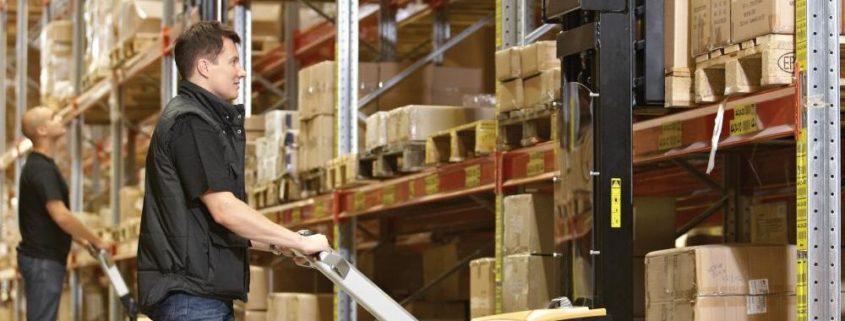What are the different types of warehouse stacker?
A warehouse stacker is a specialised tool used for lifting and moving pallets around a warehouse. There are various types of warehouse stackers available for different industries and applications. They are generally considered a cheaper alternative to investing in forklifts and other similar equipment. They require a little more physical work than a forklift, and this varies depending on the type of warehouse stacker you use. They are ideal for warehouses of restricted size, where workers use them to lift products onto racks for storage, or into vehicles for transit. Here is a guide to the various types of warehouse stacker available.
Manual stackers
A manual stacker is the most simple and affordable type, and typically has a load capacity of 5,500 lbs. It consists of a steel trolley with a hydraulic pump and lifts pallets and heavy items by manually pumping the handle up and down. The operator works the manual stacker by positioning its two forks under a pallet and raising it off the floor using the lifting mechanism. Once the load is off the ground, you can manually steer it to its destination using the handle.
An advantage of the manual stacker is that it can be easily loaded into the back of a vehicle due to its small size and lightweight. However, it isn’t ideal for moving a load over longer distances, as it is quite labour-intensive for the operator. In smaller spaces, where lift height is not too high, the manual stacker is a perfectly adequate solution.
The electric walkie behind
These are also known as walkie stackers, and they are twice the size of manual warehouse stackers. They are powered by an industrial battery or an on-board battery pack. The word ‘walkie’ refers to a stacker that the operator has to walk behind or beside, and this type has a typical load capacity of 4,500 – 6,000 lbs. The advantages of using a walkie stacker mainly revolve around the electrical assist for both driving and lifting. It also enables the operator to lift loads at the touch of a button, rather than by pumping a handle. Without needing to manually push the full weight of the load or pump the lift, this is a far less labour-intensive solution. It is also still fairly small in size, so manoeuvrability is still good.
The main disadvantage of this type of warehouse stacker is that its battery has to be charged regularly. It also requires more maintenance, because there are more moving parts and the electronics to think about. As with the manual stacker, it is often a poor choice for moving loads over longer distances because the operator still has to walk. The maximum speed is low, so the risk of collisions is minimal compared to a rider warehouse stacker. The walkie stacker is most often used at loading docks or staging areas, and for mid-distance moving of loads.
The rider stacker
A rider warehouse stacker is similar in many ways to the electric walkie behind but it has one additional feature, a riding platform. It is powered by an onboard industrial battery. Its key advantage that sets it apart is the fact that the operator can simply step onto the riding platform, rather than having to walk behind or alongside it. This makes the rider warehouse stacker a better choice for shifting loads over longer distances, in comparison to walkie or manual warehouse stackers.
The disadvantage of the rider stacker is the lack of protection afforded to the operator. Because of the way it is designed, operators have a somewhat awkward stand and are exposed to environmental hazards in the workplace. The rider warehouse stacker is heavyweight, so it has the potential to cause injury or damage to any structures it collides with. They are an ideal solution for frequent movement over longer distances and are most often found in large warehouse environments and manufacturing plants.
The centre rider
These are sometimes known as front rider warehouse stackers. They are similar to rider stackers, but with more safety and ergonomic features incorporated. They enable the operator to fully face the front or back, rather than just sideways. There is less likelihood of injury to the operator because the whole machine is protected by its chassis on two sides. However, the centre rider stacker is less manoeuvrable than the others listed so far, and the operator protection is still only partial since he/she will be exposed to the lifting mechanism.
The centre rider is best applied to environments where the machine is driven in straight lines most of the time, particularly when space is limited. Industries like general warehousing, general manufacturing and the handling of beverages are common applications for the centre rider.
The weighing scale stacker
A weighing scale stacker is quite unique because it includes a feature of displaying the total weight of the load it lifts. This is a useful feature for many loading bays and factory floors, catering to a specific niche of any industry that needs to keep track of the precise weight of each load. In some cases, a printer is also incorporated with the stackers, so that the weight and other specifications can easily be printed.
The counterbalanced walkie stackers
This advanced machine is a high lifting, electronically-powered unit with a heavyweight chassis and a lifting mast. It is designed to avoid tipping over by using the industrial battery, steel and machine components as a counterbalance to whatever load is being lifted. It is able to life loads to 100+ inches, and the counterbalanced design is compatible with use in narrow aisles as compared to a straddle stacker. This is because it doesn’t include outrigger arms that extend outside the body.
Of all the different walkie stackers, the counterbalanced one has the highest lifting mast. They typically range from around 2,600mm up to as high as 5,800mm. You can expect the counterbalanced walkie stacker to have the greatest total length, so it requires a large turning radius. For this reason, it is suitable for certain general warehouse of manufacturing environments and is often used in pharmaceuticals and cold storage outlets.
The walkie straddle stacker
This type of stacker is quite similar to the counterbalanced one, except it features outrigger arms aimed at further reducing the risk of the machine tipping over when it lifts a heavy load. There are modifications available for walkie straddle stackers, including a reaching carriage for use in narrower aisles.
Walkie straddle stackers are typically used in low- to mid-level selective racking applications, such as in a small warehouse. The lifting heights of these stackers generally range from 2,600mm to around 4,800mm, and there are various different models to choose from.
The all-terrain stacker
An all-terrain warehouse stacker is designed to carry loads up to 2,000 – 2,5000 lbs. It is lightweight but extremely robust with a strong tubular frame that can handle an even-distributed load. With large wheels, it is able to move over the majority of surfaces. It includes a 3-position handle that can lock in the up, down and neutral positions, and is mostly applied in gravel pits, plant nurseries and construction sites.
Design variations
There are different variations on the design of warehouse stackers that make them suitable for specific applications. Here are 4 of the most common options you’ll find.
- Adjustable: with an adjustable stacker, the forks can be moved into broader and narrower widths. This is particularly useful for industries where the pallets come in different sizes. Various brands offer models with an adjustable design.
- Stainless Steel: Some pallet jacks are specially made from stainless steel. These are galvanised to make them more resistant to moisture. This is particularly important when your stacker is frequently exposed to the elements, or when corrosive materials are being handled. For this reason, the stainless steel variant is often used in laboratories, clean rooms and all manner of outdoor environment.
- Narrow: Narrow warehouse stackers are designed to have the same loading capacity of a manual stacker; around 5,500 lbs. But with this variant, the overall width is considerably less – perhaps knocking off as much as 9 inches from the width. These are useful for special applications in tight spaces or where smaller pallets are used.
- Mini: The mini variant is designed to be supremely lightweight and easy to manoeuvre. It can weigh as little as 31kg, which means it is easy to carry and compact enough to load straight into a vehicle. There is no hydraulic pump on this type, so it is primarily used for moving loads around but not lifting it up high. This also means there is minimal maintenance, and you won’t experience oil leaks or need to replace seals. The typical load capacity of a mini stacker is around 1,100 lbs.
So there you have it, a basic guide to the types of warehouse stacker and pallet jack that are available. They all have their strengths and weaknesses, so you will have to weigh up the needs of your specific environment to ascertain which type of jack will be best for you. In any case, they are an essential tool for moving heavy loads around your facility and lifting them to stack on top of one another.
If the expense of a forklift truck is too prohibitive for your budget, a warehouse stacker or pallet jack is a good compromise. We hope this rough guide will serve as a good starting point for you to begin your search, and we can offer further advice on what the best solution might be for you. If you have any questions, please don’t hesitate to get in touch for stackers for sales or hire.



